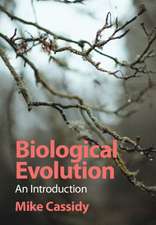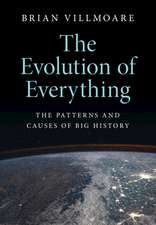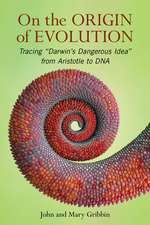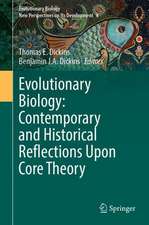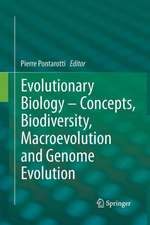Stardust: The Cosmic Seeds of Life: Astronomers' Universe
Autor Sun Kwoken Limba Engleză Paperback – 18 apr 2013
In this book, the author describes stunning discoveries in astronomy and solar system science made over the last 10 years that have yielded a new perspective on the origin of life.
Other interesting topics discussed in this book
- The discovery of diamonds and other gemstones in space
- The origin of oil
- Neon signs and fluorescent lights in space
- Smoke from the stars
- Stardust in our hands
- Where oceans come from
- The possibility of bacteria in space
Din seria Astronomers' Universe
-
 Preț: 210.44 lei
Preț: 210.44 lei -
 Preț: 207.15 lei
Preț: 207.15 lei -
 Preț: 195.53 lei
Preț: 195.53 lei -
 Preț: 254.90 lei
Preț: 254.90 lei -
 Preț: 284.56 lei
Preț: 284.56 lei -
 Preț: 212.88 lei
Preț: 212.88 lei -
 Preț: 256.41 lei
Preț: 256.41 lei -
 Preț: 264.35 lei
Preț: 264.35 lei -
 Preț: 259.08 lei
Preț: 259.08 lei -
 Preț: 227.61 lei
Preț: 227.61 lei -
 Preț: 305.70 lei
Preț: 305.70 lei -
 Preț: 253.11 lei
Preț: 253.11 lei -
 Preț: 216.60 lei
Preț: 216.60 lei -
 Preț: 272.24 lei
Preț: 272.24 lei -
 Preț: 330.75 lei
Preț: 330.75 lei -
 Preț: 179.00 lei
Preț: 179.00 lei -
 Preț: 289.83 lei
Preț: 289.83 lei -
 Preț: 160.03 lei
Preț: 160.03 lei -
 Preț: 200.80 lei
Preț: 200.80 lei -
 Preț: 255.97 lei
Preț: 255.97 lei -
 Preț: 242.58 lei
Preț: 242.58 lei -
 Preț: 262.55 lei
Preț: 262.55 lei -
 Preț: 282.38 lei
Preț: 282.38 lei -
 Preț: 187.82 lei
Preț: 187.82 lei -
 Preț: 225.19 lei
Preț: 225.19 lei -
 Preț: 207.64 lei
Preț: 207.64 lei -
 Preț: 104.35 lei
Preț: 104.35 lei -
 Preț: 188.94 lei
Preț: 188.94 lei -
 Preț: 270.49 lei
Preț: 270.49 lei -
 Preț: 212.01 lei
Preț: 212.01 lei -
 Preț: 169.08 lei
Preț: 169.08 lei -
 Preț: 210.01 lei
Preț: 210.01 lei -
 Preț: 208.26 lei
Preț: 208.26 lei -
 Preț: 253.98 lei
Preț: 253.98 lei -
 Preț: 180.12 lei
Preț: 180.12 lei -
 Preț: 280.19 lei
Preț: 280.19 lei -
 Preț: 273.13 lei
Preț: 273.13 lei -
 Preț: 207.39 lei
Preț: 207.39 lei -
 Preț: 208.70 lei
Preț: 208.70 lei -
 Preț: 214.86 lei
Preț: 214.86 lei -
 Preț: 188.94 lei
Preț: 188.94 lei -
 Preț: 194.65 lei
Preț: 194.65 lei -
 Preț: 277.34 lei
Preț: 277.34 lei -
 Preț: 187.15 lei
Preț: 187.15 lei -
 Preț: 210.93 lei
Preț: 210.93 lei -
 Preț: 212.01 lei
Preț: 212.01 lei
Preț: 277.98 lei
Nou
Puncte Express: 417
Preț estimativ în valută:
53.19€ • 55.43$ • 44.04£
53.19€ • 55.43$ • 44.04£
Carte disponibilă
Livrare economică 13-27 martie
Preluare comenzi: 021 569.72.76
Specificații
ISBN-13: 9783642328015
ISBN-10: 3642328016
Pagini: 280
Ilustrații: XXII, 267 p. 74 illus., 50 illus. in color.
Dimensiuni: 155 x 235 x 20 mm
Greutate: 0.41 kg
Ediția:2013
Editura: Springer Berlin, Heidelberg
Colecția Springer
Seria Astronomers' Universe
Locul publicării:Berlin, Heidelberg, Germany
ISBN-10: 3642328016
Pagini: 280
Ilustrații: XXII, 267 p. 74 illus., 50 illus. in color.
Dimensiuni: 155 x 235 x 20 mm
Greutate: 0.41 kg
Ediția:2013
Editura: Springer Berlin, Heidelberg
Colecția Springer
Seria Astronomers' Universe
Locul publicării:Berlin, Heidelberg, Germany
Public țintă
Popular/generalCuprins
1. Where do we come from?.- 2. Rocks and dust in the planetary neighborhood.- 3. Impacts from beyond.- 4. Descendants of stars.- 5. Glowing in the dark.- 6. Star dust in our eyes.- 7. The oldest and brightest.- 8. Neon signs in the sky.- 9. Stars as molecular factories.- 10. Smoke from stellar chimneys.- 11. Gems from Heaven.- 12. Diamonds in the sky.- 13. A mysterious red glow.- 14. A celestial origin for oil?.- 15. Organics in our Solar System.- 16. Stardust in our hands.- 17. Bacteria in space?.- 18. Comets: messengers from the past.- 19. Where do oceans come from?.- 20. Playing God with primordial soup.- 21. Stardust and origin of life.- 22. Our place in the Universe.- 23. Bibliography.- 24. Appendix I. Scientific notation.- 25. Appendix II. Units of measurement.- 26. Appendix III Color and Temperature.- 27. Appendix IV: Naming convention of astronomical objects.- 28. Appendix V Elemental abundance.- 29. Appendix VI Mass and energy.- 30. Glossary.
Recenzii
From the reviews:
Selected by Choice magazine as an "Outstanding Academic Title" for 2014
“Stardust is a very readable, lucid description of the origins of life, from the standpoint of an astronomer. … Six appendixes, a 10-page glossary, and a 20-page bibliography support the text. Summing Up: Highly recommended. General readers and lower-division undergraduates.” (E. S. Perlman, Choice, Vol. 51 (5), January, 2014)
Selected by Choice magazine as an "Outstanding Academic Title" for 2014
“Stardust is a very readable, lucid description of the origins of life, from the standpoint of an astronomer. … Six appendixes, a 10-page glossary, and a 20-page bibliography support the text. Summing Up: Highly recommended. General readers and lower-division undergraduates.” (E. S. Perlman, Choice, Vol. 51 (5), January, 2014)
Notă biografică
Sun Kwok is a leading world authority on the subject of astrochemistry and stellar evolution. He is best known for his theory on the origin of planetary nebulae and the death of Sun-like stars. His recent research has been on the topic of the synthesis of complex organic compounds in the late stages of stellar evolution. He is the author of a number of books, including Cosmic Butterflies : The Colorful Mysteries of Planetary Nebulae.
Textul de pe ultima copertă
How did life originate on Earth? For over 50 years, scientists believed that life was the result of a chemical reaction involving simple molecules such as methane and ammonia cooking in a primordial soup. Recent space observations have revealed that old stars are capable of making very complex organic compounds. At some point in their evolution, stars eject those organics and spread them all over the Milky Way galaxy. There is evidence that these organic dust particles actually reached the early Solar System. Through bombardments by comets and asteroids, the young Earth inherited significant amounts of stardust. Was the development of life assisted by the arrival of these extraterrestrial materials?
In this book, the author describes stunning discoveries in astronomy and solar system science made over the last 10 years that have yielded a new perspective on the origin of life.
Other interesting topics discussed in this book
About the author
Sun Kwok is a leading world authority on the subject of astrochemistry and stellar evolution. He is best known for his theory on the origin of planetary nebulae and the death of Sun-like stars. His most recent research has been on the synthesis of complex organic compounds in the late stages of stellar evolution. He is the author of a number of books, including Cosmic Butterflies: The Colorful Mysteries of Planetary Nebulae.
In this book, the author describes stunning discoveries in astronomy and solar system science made over the last 10 years that have yielded a new perspective on the origin of life.
Other interesting topics discussed in this book
- The discovery of diamonds and other gemstones in space
- The origin of oil
- Neon signs and fluorescent lights in space
- Smoke from the stars
- Stardust in our hands
- Where oceans come from
- The possibility of bacteria in space
About the author
Sun Kwok is a leading world authority on the subject of astrochemistry and stellar evolution. He is best known for his theory on the origin of planetary nebulae and the death of Sun-like stars. His most recent research has been on the synthesis of complex organic compounds in the late stages of stellar evolution. He is the author of a number of books, including Cosmic Butterflies: The Colorful Mysteries of Planetary Nebulae.
Caracteristici
Uses everyday experience and common things found on Earth (fire, chimneys, factories, oil) to playfully introduce non-experts to the principles of astrochemistry Presents a popular account of the history of the discovery and latest understanding of organic matter in space, and the potential impacts of these discoveries on the understanding of the origin of life Provides understandable insights into the building blocks of life and their stellar origin Explains that every atom in our body has at one time been inside a star or was made by a star A refreshing change from the mainstream popular astronomy and astrobiology books Includes supplementary material: sn.pub/extras









